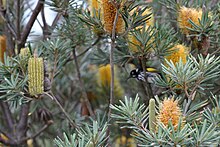
Banksia is a genus of around 170 species of flowering plants in the family Proteaceae. These Australian wildflowers and popular garden plants are easily recognised by their characteristic flower spikes, and woody fruiting "cones" and heads. Banksias range in size from prostrate woody shrubs to trees up to 30 metres (100 ft) tall. They are found in a wide variety of landscapes: sclerophyll forest, (occasionally) rainforest, shrubland, and some more arid landscapes, though not in Australia's deserts.

Banksia coccinea, commonly known as the scarlet banksia, waratah banksia or Albany banksia, is an erect shrub or small tree in the family Proteaceae. Its distribution in the wild is along the southwest coast of Western Australia, from Denmark to the Stokes National Park, and north to the Stirling Range, growing on white or grey sand in shrubland, heath or open woodland. Reaching up to 8 m (26 ft) in height, it is a single-stemmed plant that has oblong leaves, which are 3–9 cm (1.2–3.5 in) long and 2–7 cm (0.8–2.8 in) wide. The prominent red and white flower spikes appear mainly in the spring. As they age they develop small follicles that store seeds until opened by fire. Though widely occurring, it is highly sensitive to dieback and large populations of plants have succumbed to the disease.
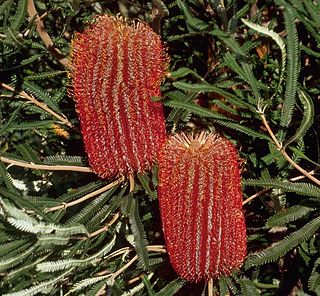
Banksia brownii, commonly known as feather-leaved banksia or Brown's banksia, is a species of shrub that grows in southwest Western Australia. A plant with fine feathery leaves and large red-brown flower spikes, it usually grows as an upright bush around two metres (6.6 ft) high, but can also occur as a small tree or a low spreading shrub. First collected in 1829 and published the following year, it is placed in Banksiasubgenus Banksia, section Oncostylis, series Spicigerae. There are two genetically distinct forms.

Banksia ericifolia, the heath-leaved banksia, or lantern banksia, is a species of woody shrub of the family Proteaceae native to Australia. It grows in two separate regions of Central and Northern New South Wales east of the Great Dividing Range. Well known for its orange or red autumn inflorescences, which contrast with its green fine-leaved heath-like foliage, it is a medium to large shrub that can reach 6 m (20 ft) high and wide, though is usually half that size. In exposed heathlands and coastal areas, it is more often 1–2 m (3.3–6.6 ft).

Banksia spinulosa, the hairpin banksia, is a species of woody shrub, of the genus Banksia in the family Proteaceae, native to eastern Australia. Widely distributed, it is found as an understorey plant in open dry forest or heathland from Victoria to northern Queensland, generally on sandstone though sometimes also clay soils. It generally grows as a small shrub to 2 metres (7 ft) in height, though can be a straggly tree to 6 metres (20 ft). It has long narrow leaves with inflorescences which can vary considerably in coloration; while the spikes are gold or less commonly yellowish, the emergent styles may be a wide range of colours – from black, purple, red, orange or yellow.

Banksia menziesii, commonly known as firewood banksia, is a species of flowering plant in the family Proteaceae. It is a gnarled tree up to 10 m (33 ft) tall, or a lower spreading 1–3 m (3.3–9.8 ft) shrub in the more northern parts of its range. The serrated leaves are dull green with new growth a paler grey green. The prominent autumn and winter inflorescences are often two-coloured red or pink and yellow, and their colour has given rise to more unusual common names such as port wine banksia and strawberry banksia. Yellow blooms are rarely seen.

As with other flowering plants, the taxonomy of Banksia has traditionally been based on anatomical and morphological properties of the Banksia flower, fruiting structure and seed, along with secondary characteristics such as leaf structure and growth habit. Increasingly, molecular evidence from DNA is providing important new insights into relationships within the genus and between this and other genera in the Proteaceae.
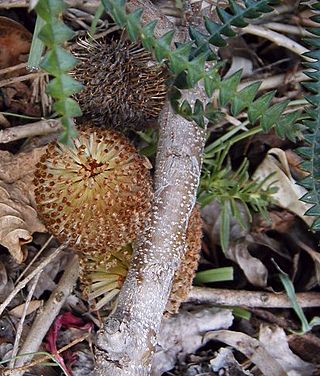
Banksia dryandroides, the dryandra-leaved banksia, is a species of small shrub in the plant genus Banksia. The Noongar peoples know the tree as manyat. It occurs in shrubland, woodland and kwongan on the south coast of Western Australia between Narrikup and Beaufort Inlet. The species is placed alone in series B. ser. Dryandroideae.

Banksia nutans, commonly known as nodding banksia, is a species of shrub native to the south coast of Western Australia in the genus Banksia. Growing to a metre (3 ft) tall, it has pale blue-green fine-leaved foliage and unusual purple-brown inflorescences which hang upside down rather than grow upright like most other banksias.
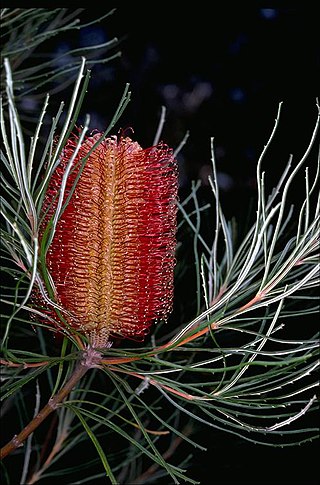
Banksia occidentalis, commonly known as the red swamp banksia, is a species of shrub or small tree that is endemic to the south coast of Western Australia. It has smooth bark, linear, sparsely serrated leaves, golden flowers in a cylindrical spike, and later up to sixty follicles in each spike.
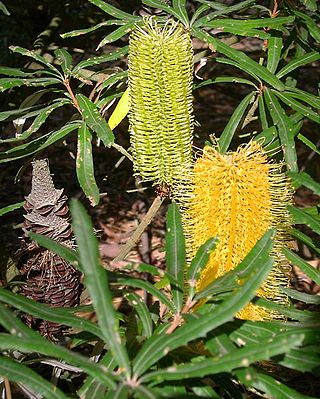
Banksia seminuda, commonly known as the river banksia, is a tree in the family Proteaceae. It is found in southwest Western Australia from Dwellingup (32°42′ S) to the Broke Inlet east of Denmark (34°57′ S). It is often mistaken for, and was originally considered a subspecies of, the Banksia littoralis. Stephen Hopper described the subspecies remanens as a short-leaved shrubby form found in the coastal sands below granite outcrops in the Walpole-Nornalup National Park. However, George does not feel this form warrants taxonomic recognition as it lies within the normal variability of the species and there was no clear distinction between it and the other populations of B. seminuda.

Banksia telmatiaea, commonly known as swamp fox banksia or rarely marsh banksia, is a shrub that grows in marshes and swamps along the lower west coast of Australia. It grows as an upright bush up to 2 metres tall, with narrow leaves and a pale brown flower spike, which can produce profuse quantities of nectar. First collected in the 1840s, it was not published as a separate species until 1981; as with several other similar species it was previously included in B. sphaerocarpa.
The ecology of Banksia is the relationships and interactions among the plant genus Banksia and its environment. Banksia has a number of adaptations that have so far enabled the genus to survive despite dry, nutrient-poor soil, low rates of seed set, high rates of seed predation and low rates of seedling survival. These adaptations include proteoid roots and lignotubers; specialised floral structures that attract nectariferous animals and ensure effective pollen transfer; and the release of seed in response to bushfire.

Banksia ser. Spicigerae is a taxonomic series in the genus Banksia. It consists of the seven species in section Oncostylis that have cylindrical inflorescences. These range in form from small shrubs to tall trees. The leaves grow in either an alternate or whorled pattern, with various shape forms. The Spicigerae inflorescence is held erect, subtended by a whorl of branchlets, and retains a regular pattern until anthesis. The perianth limb is horizontal until anthesis, at which point the perianth opens from underneath. The pollen-presenter is ovoid or conical. The seed wings are not notched.
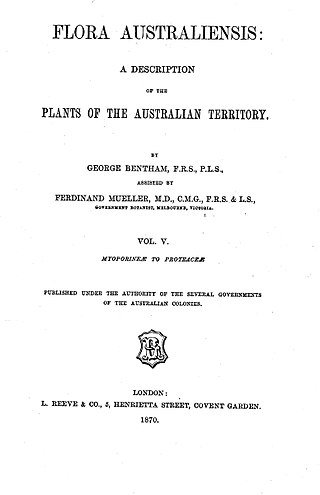
George Bentham's taxonomic arrangement of Banksia was published in 1870, in Volume 5 of Bentham's Flora Australiensis. A substantial improvement on the previous arrangement, it would stand for over a century. It was eventually replaced by Alex George's 1981 arrangement, published in his classic monograph The genus Banksia L.f. (Proteaceae).
Kevin Thiele and Pauline Ladiges taxonomic arrangement of Banksia, published in 1996, was a novel taxonomic arrangement that was intended to align the taxonomy of Banksia more closely with the phylogeny that they had inferred from their cladistic analysis of the genus. It replaced Alex George's 1981 arrangement, but most aspects were not accepted by George, and it was soon replaced by a 1999 revision of George's arrangement. However some herbaria have continued to follow Thiele and Ladiges on some points.

Alex George's taxonomic arrangement of Banksia was the first modern-day arrangement for that genus. First published in 1981 in the classic monograph The genus Banksia L.f. (Proteaceae), it superseded the arrangement of George Bentham, which had stood for over a hundred years. It was overturned in 1996 by Kevin Thiele and Pauline Ladiges, but restored by George in 1999. A recent publication by Austin Mast and Kevin Thiele suggests that it will soon be overturned again.

Banksia spinulosa var. collina is a shrub that grows along the east coast of Australia, in Queensland and New South Wales. Commonly known as Hill Banksia or Golden Candlesticks, it is a taxonomic variety of B. spinulosa. It is a popular garden plant widely sold in nurseries.

Banksia spinulosa var. spinulosa is a shrub that grows along the east coast of Australia, in Queensland and New South Wales.
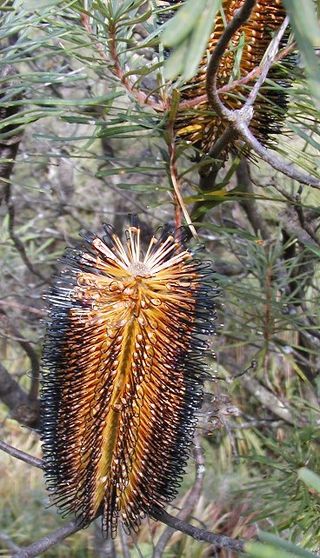
Banksia spinulosa var. cunninghamii, sometimes given species rank as Banksia cunninghamii, is a shrub that grows along the east coast of Australia, in Victoria and New South Wales. It is a fast-growing non-lignotuberous shrub or small tree infrequently cultivated.
